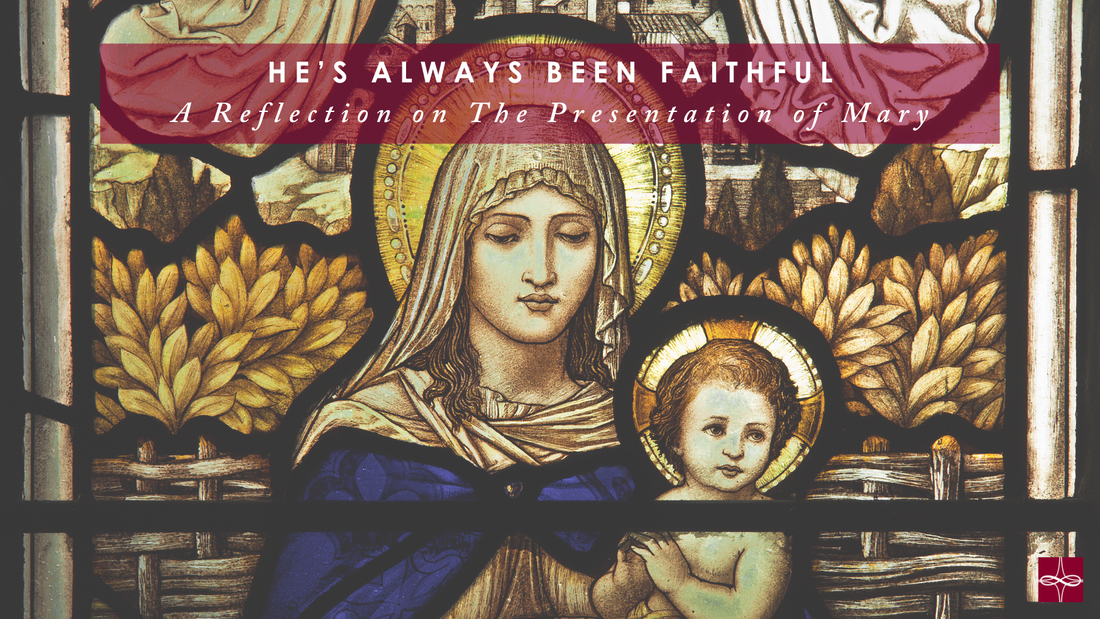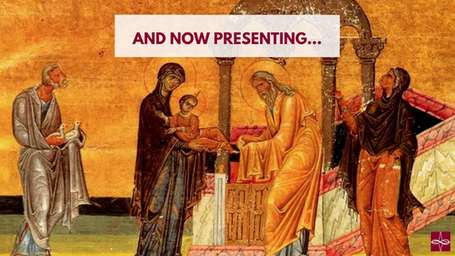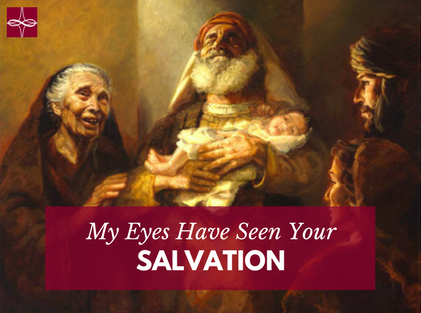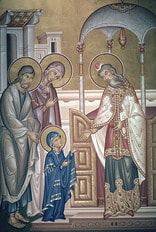|
Last Tuesday, November 21, we celebrated the feast of the Presentation of Mary. According to tradition on this day, Mary, at the age of 3, was presented in the temple by her parents St. Ann and St. Joachim, and her life was consecrated to God. For many years this feast was something I didn’t understand, and it wasn’t until last spring when I had the opportunity to visit the Holy Land that I was able to more fully appreciate this beautiful feast. When in the Old City of Jerusalem, you are able to see how small the city was at the time of Jesus’s life. One example of this is the proximity of the place where Mary was presented to Mount Calvary. It only takes a few minutes to walk from one place to another. During the passion, Mary would have passed this place. In other words, in the midst of the greatest suffering of her life, Mary would have passed the place where her parents, in gratitude, gave her life entirely to God – the place where her ‘fiat’ began. I often find myself meditating on this idea when praying the fourth sorrowful mystery of the Rosary – that Mary in suffering would be consoled with the memory of God’s faithfulness to her parents in bringing them a child. In passing the place where both she and her son were presented to God, how her heart must have felt both the overwhelming joy and premature sorrow of the sword Simeon promised would pierce her heart as he sang his canticle rejoicing in the Incarnation. In the midst of watching her only Beloved Son mocked, beaten, and killed, she remembered the song of her Magnificat and sang the praises of the psalms in her heart. Her heart must have been pulled into the prayer of Psalm 23 as she walked up towards Golgotha, “Even though I walk in the valley of the shadow of death, I fear no evil for you are with me; your rod and your staff comfort me.” Mary did not forget that God had been faithful her entire life, and did not doubt His faithfulness at the darkest hour of history. Rather, she clung to Him and obediently received His will, despite the sorrow it caused her immaculate heart. We learn to suffer well from the model of Our Blessed Mother, and one of the most important aspects of faith in suffering is to remember God’s own faithfulness. Like Mary, we can turn back towards God in the midst of suffering, we can remember the moment that we met Jesus and our lives changed, remember the moments where we experienced the overwhelming radical love of God, and hold onto that love and faithfulness as truth. Mary’s presentation calls us to reflect on all the different times throughout our life that we have seen God be faithful, and trust that He will be faithful once again. This feast calls us to give ourselves wholly to God as Mary did, and trust that His will be done – and that His will is good – in all things.
0 Comments
Tomorrow we celebrate the feast of the Presentation of Our Lord in the Temple. In the Eastern Churches, it’s called the Meeting or Encounter with Simeon and Anna. I like that title better. An encounter with an “other” is so much richer than a presentation. A presentation sounds a bit too showy. I feel as if there should be an announcer in a coattails and top hat booming into a megaphone in front of audience. But an encounter… An encounter speaks of something intimate, something quiet, something small yet powerful enough to require your whole attention. Pope Benedict XVI said in his encyclical, Deus Caritas Est, “Being Christian is not the result of an ethical choice or a lofty idea, but the encounter with an event, a person, which gives life a new horizon and a decisive direction.” Simeon and Anna encountered the baby Jesus and it changed their lives. The joy that was born in their hearts was unlike anything they had experienced. Simeon and Anna can teach us how to encounter the Lord with joy. Simeon and Anna represent the whole of Israel and us, the Church. They are the male and female representatives of their nation, and in them, Jesus meets all of Israel who have been longing for a savior. They were both advanced in years. They, and all of the people of Israel, were familiar with waiting. In the same way, Simeon and Anna represent us, the Church, who seek the face of the Lord and redemption. Not everyone was privileged to be there in Jerusalem to see the month-old incarnate God, but through Simeon and Anna we all participate in this encounter in preparation for our own unique meeting with Christ. We must ask, where do we encounter Christ? Simeon and Anna were in the Temple, and that is where we can seek him as well. Not necessarily the Temple in Jerusalem, but the house of God. In the liturgies of the Church, in Mass, in prayer, we find the one whom our soul desires. It is specifically in the Eucharist that Jesus keeps his promise literally, “Behold, I am with you always, until the end of the age.” I was blessed to grow up in a diocese that deeply valued Perpetual Adoration chapels. It seemed as if every other church had one. If we seek Christ where we know he will be, we are sure to encounter him. The Eucharist is a great place to start. It is also possible to have a spiritual experience in nature, and praying on a mountain peak is one of my favorite things to do. But if I want to be with Jesus physically, I go to Church. If I want to hear him speak to me, I read the Bible. I also encounter him in my spiritual companions, who are temples of the Holy Spirit as a result of baptism. As C.S. Lewis said in The Weight of Glory, “Next to the Blessed Sacrament itself, your neighbor is the holiest object present to your senses.” These are some of the places we can encounter Christ, where he waits to meet us and give us rest. Let us also look to these two elders of Israel, Simeon and Anna, to teach us about preparing for an encounter with the Lord. In them, we see examples of patience, attentiveness, longing, hope, and joy. Simeon’s reaction to seeing and holding the child Jesus was “Now You may let your servant depart in peace.” He was ready to die, to sleep, to rest in the peace of his forefathers. He has seen the one for whom he had hoped, the savior of his people, and his hope was fulfilled. Finally, he can rest. Anna recognizes Jesus and His mission, and proclaimed it to all who would listen, sharing her knowledge and her joy. Anna was a prophetess, one who was known to speak of God’s will for his people. Because she was so close to God in prayer, she was able to see Him when He entered into her world. She was ready for her Lord to share His life with her, even in such a small way. We can emulate them by being attentive to the movements of the Holy Spirit in our hearts, by accepting the gifts we are given in their due time, and by sharing our joy with others as witnesses of God’s work in the world. By preparing our hearts in this way, we too can encounter our Savior in the imminent and intimate manner which He desires to share specifically with us.
As we brought our firstborn son in a white gown to the church, I couldn’t help but think of Mary and Joseph - new parents who also came to God’s dwelling place with a newborn child. They were fulfilling the stipulations of the Mosaic law: Mary was completing her ritual purification after childbirth, and the couple was consecrating their firstborn son to God (cf Exodus 13:2). They, like my husband and I, were entrusting their child to God in faith, giving the Lord control over his destiny, reiterating, in a sense, Mary’s surrender in her Magnificat, “may it be done to him according to your word.”
The Feast of the Presentation of the Lord which we celebrate today is one of both great joy and great sorrow—a day of paradox. The glory of the Lord in a literal sense returns to the Temple in Jerusalem which had for so many years been vacant of his physical presence. God has come to renew his covenant and relationship with his people. His presence, however, is no longer confined to this Temple. He walks now among his people…as one of them – in this case, in the form of a child. All of Israel’s hopes are fulfilled in this one child. “My eyes have seen your salvation,” the holy Simeon proclaims in the Temple, “a light for revelation to the Gentiles, and glory for your people Israel.” The Jewish people’s spiritual exile from God has come to an end. This child, this sign of hope and restoration of Israel, however, is also a sign to be misunderstood and rejected. Simeon continues, explicitly telling Mary, "Behold, this child is destined for the fall and rise of many in Israel, and to be a sign that will be contradicted and you yourself a sword will pierce.” God was answering the many prayers and dreams of the Israelites in a way they could hardly comprehend: in the form of a lowly child who would grow up in a foreign country, who would come back to Nazareth and live as a poor carpenter’s son, who would grow to become a great prophet after thirty years and challenge the Jewish people to live more nobly than they could have ever imagined: to love their enemies and persecutors, to eat his Body and drink his Blood, to become sons and daughters of God, calling him “abba,” Father, and ultimately to attain salvation for the entire world. God often answers our prayer in ways unimagined or seemingly incomprehensible to us. Will we join in Simeon’s proclamation of salvation or will we be among those who reject this sign? “My eyes have seen your salvation” - this is at the heart of the Christian life. This is evangelization: an encounter with the living God that results in our conversion and proclamation of salvation. As Pope Francis said in last year’s homily on the Feast of the Presentation, “One who lives this encounter becomes a witness and makes possible the encounter for others.” After encountering Christ, we are able to reiterate the words of Simeon, “My eyes have seen your salvation.” Are you able to join in these words? In order to do so, we must prepare our hearts for an encounter with God. What I find crucial to the words of Simeon, which are followed by words of the prophetess Anna in the Gospel today, is the role of prayer and sacrifice to Simeon and Anna’s encounter. Years of fasting, offering sacrifice, going to the Temple, and forming a deep relationship with God in prayer all led to this pivotal moment of encounter in their lives. Furthermore, Simeon enters the Temple after the prompting of the Holy Spirit. He was so receptive to the stirring of God within his heart that he entered the Temple in the very moment he needed to. Both he and Anna were not in the Temple by accident. God had been preparing their hearts for years, and they had done everything in their power to cooperate with his grace through their holy actions: prayer, sacrifice, worship, thanksgiving. What do we bring to the Lord today as we celebrate the Feast of the Presentation? What do we place on his altar every time we attend Mass? Do we join the priest in offering sacrifice of praise, thanksgiving, or petition? Do we remember the needs of friends, family, or the world? Do we give God our joys, sorrows, stresses, or work? I invite you, the next time you go to Mass, to present yourself to the Lord. Spiritually place yourself on the altar, wherever you may be in your faith. Whether you feel a bit distant from God right now, seem to be in a comfortable place in your life, or are overwhelmed with fear or stress or worry—place whatever you have and whatever you carry on the altar this week and ask God to continue to transfigure you. We celebrate, in a sense, the Presentation of the Lord at every Mass—for we are presenting Jesus himself to God the Father in the Eucharist. And we are invited to join in offering our sacrifices to the Eternal Sacrifice of Christ crucified. Let us join the aged Simeon in saying, “my eyes have seen your salvation!” by imitating his deep life of prayer and sacrifice. And from there, may we proclaim the truth of God’s love to the world! Sacred Scripture is silent on the childhood of the Blessed Mother, but for centuries Catholics in both the Eastern and Western Church have celebrated the moment that she was presented in the temple. This is especially true in the Eastern Church. Tradition (with a small “t”) holds that Saints Joachim and Anne brought their little girl to the temple when she was about three years old. They recognized that she was a gift from God and in their gratitude for the incredible blessing they had received; they wanted to present her back to God.
Our Lady’s presentation in the temple is more than just a touching story of an elderly couple offering their precious child back to God. It can serve as a beautiful reminder that, by the nature of our own baptisms, we too have been given back to God. This is true, regardless of whether that baptism was of the tiniest of babies or this past Easter Vigil. From the very beginning, God had chosen the Blessed Mother to be His own mother. As a baptized Christian disciple, God has a special mission in mind for you. He has a plan for each one of us. By the nature of our baptism, God calls us to become a part of the New Evangelization, to become a missionary disciple of Christ. This mission will look a little different for each one of us. Some might be called to be missionaries in faraway lands, while the majority may be missionaries in their own backyard. Living out your baptismal call can be as simple as spreading the Gospel to a coworker or friend. It can take the shape of helping someone in need. It might be inviting a neighbor to attend Mass with you followed by a fun activity. Many years after her presentation, the Blessed Mother told God “yes” when He asked her to become the mother of His dearly beloved Son. What God asked probably seemed scary. She may not have fully understood all that God was asking of her, but she trusted in Him and said “yes.” It should be the same with us. Even though it might mean stepping outside of our comfort zone or risking embarrassment, God calls each of His baptized children to take a risk and share the Good News. Saints Joachim and Anne recognized that their little girl was something precious from God and that she belonged to God. The Feast of the Presentation of Mary in the Temple tomorrow can serve as a real reminder of our baptisms and that we too belong only to God. What a blessing that is! Jennifer Beckmann is an Administrative Secretary for the United States Conference of Catholic Bishops. The night before I travel - whether by car, air or sea - I can’t help but begin to feel anxious and get a little overwhelmed about my upcoming journey. No matter how prepared I think I am or how necessary the trip is, I loathe the process of travelling. I’ve never had a ‘bad’ experience, but it isn’t something on my list of things to do every day either. While I’m sure I’m not alone in my sentiment, and there are probably 101 diagnoses as to why I don’t like travelling, I think it boils down to the fact that transition, no matter the circumstances, causes an upheaval of routine.
Throughout our lives, each of us has experienced the anxieties of transition in one way or another: graduating from school and starting a new job; getting married and having children; getting sick or losing a loved one. Every stage of our lives carries with it transition and to some extent, a change in routine. The Book of Ecclesiastes acknowledges this idea in a very poetic way: “There is an appointed time for everything, and a time for every affair under the heavens” (Eccl 3:1). The start of Ordinary Time is no different. While most of us would consider this transition as minimal, the truth is our ‘routine of solemnity’ has come to somewhat of a standstill for the next month. The Solemnity of the Presentation of the Lord (on February 2), and the memorial of Our Lady of Lourdes (on February 11) are among the highlights, but for the non-daily Mass crowd, they will be passed over with little thought. So, the question then becomes, what are we to make of these next few weeks? With less than a month before we begin our celebration of Lent with Ash Wednesday, many of us are tempted to ask what good these next four weeks of green - of Ordinary Time - truly serve? In fact, we might be tempted to brush them aside and regard them as a welcomed break in our otherwise hectic liturgical year. I would suggest, however, that looking at these next four ordinary weeks is essential to our spiritual well-being. Our Catholic faith has a rich history of using the ordinary to reveal the extraordinary. Our sacramental life is centered around the idea that ordinary elements - bread, wine, water, oil, gestures and even people - through the grace of God, constantly reveal extraordinary truths. Even in our secular day to day interactions, we believe that God reveals himself to us through the kind word or action of an ordinary passerby; oftentimes to our amazement. Both the Old and New Testaments tell countless stories of God using ordinary people to bring about His extraordinary plan of salvation: Abraham, Moses, David, Elijah, Elisha, Daniel, Jonah, John the Baptist, Peter and Paul, just to name a few. The lives of the saints and martyrs are no exception. Ss. Francis, Therese of Lisieux, Jerome, Vincent Pallotti, Elizabeth Ann Seton, Francis de Sales, among thousands of others, beautifully exemplify living ordinary lives for the sake of an extraordinary message. Knowing and understanding how God uses the ordinary should be a great source of hope for each of us. It is an invitation for each of us to strip away what we think we need to be and come as we are; in other words, for us to recognize the beauty of our own imperfect humanity. It is through our participation in the ordinary that we enter into a deeper, more honest and fruitful relationship with God, who is perfection. It’s true that this liturgical season, this transition, might bring about some uneasiness or anxiety because it is a break from our recent pomp and solemnity. For some, it might be a minimal, casual transition. And still for others, it might be off their radar completely. Whatever the case, I would suggest making these next four weeks truly ordinary. If we come as we are - as ordinary people - not just to reacclimate ourselves to a different routine, but to enter into an honest dialogue with God, I am confident He will use us in extraordinary ways. This kind of unique and authentic vulnerability is what we are called to, and why we were created. Why not take a little time to participate in it and enjoy it? On January 24th, we will celebrate the memorial of St. Francis de Sales. In his book, The Introduction to the Devout Life, he writes, “When God the Creator made all things, he commanded the plants to bring forth fruit each according to its own kind; he has likewise commanded Christians, who are the living plants of his Church, to bring forth the fruits of devotion, each one in accord with his character, his station and his calling… Therefore, in whatever situations we happen to be, we can and we must aspire to the life of perfection” (Pars 1, cap.3). As we begin this short period of Ordinary Time, we are reminded not of what we lack, but of why being ordinary is so necessary to bring about the extraordinary. We are reminded that each of us have been created as is, to bring about a life of devotion, not for our sake, but for the glory of God. In essence, we are reminded why the green of the thorn, eventually blooms into the white of the rose. Happy Ordinary Time! Jonathan Jerome is the Director of Catholic Campus Ministry at the University of Pittsburgh Johnstown. |
Details
Archives
July 2024
Categories
All
|
About |
Media |
© COPYRIGHT 2024 | ALL RIGHTS RESERVED









 RSS Feed
RSS Feed